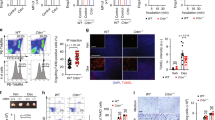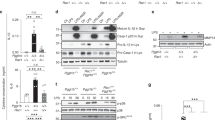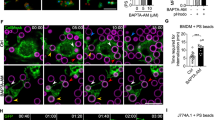Abstract
Fc receptor (FcR)–mediated phagocytosis requires activation of the Rho GTPases Cdc42 and Rac1, but how they are recruited to the FcR is unknown. Here we show that the calcium-promoted Ras inactivator (CAPRI), a Ras GTPase-activating protein, functions as an adaptor for Cdc42 and Rac1 during FcR-mediated phagocytosis. CAPRI-deficient macrophages had impaired FcγR-mediated phagocytosis and oxidative burst, as well as defective activation of Cdc42 and Rac1. CAPRI interacted constitutively with both Cdc42 and Rac1 and translocated to phagocytic cups during FcγR-mediated phagocytosis. CAPRI-deficient mice had an impaired innate immune response to bacterial infection. These results suggest that CAPRI provides a link between FcγR and Cdc42 and Rac1 and is essential for innate immune responses.
This is a preview of subscription content, access via your institution
Access options
Subscribe to this journal
Receive 12 print issues and online access
$209.00 per year
only $17.42 per issue
Buy this article
- Purchase on Springer Link
- Instant access to full article PDF
Prices may be subject to local taxes which are calculated during checkout








Similar content being viewed by others
References
Underhill, D.M. & Ozinsky, A. Phagocytosis of microbes: complexity in action. Annu. Rev. Immunol. 20, 825–852 (2002).
Cox, D. & Greenberg, S. Phagocytic signaling strategies: Fc(γ)receptor-mediated phagocytosis as a model system. Semin. Immunol. 13, 339–345 (2001).
Garcia-Garcia, E. & Rosales, C. Signal transduction during Fc receptor-mediated phagocytosis. J. Leukoc. Biol. 72, 1092–1108 (2002).
Ravetch, J.V. & Bolland, S. IgG Fc receptors. Annu. Rev. Immunol. 19, 275–290 (2001).
Daeron, M. Fc receptor biology. Annu. Rev. Immunol. 15, 203–234 (1997).
Fitzer-Attas, C.J. et al. Fcγ receptor-mediated phagocytosis in macrophages lacking the Src family tyrosine kinases Hck, Fgr, and Lyn. J. Exp. Med. 191, 669–682 (2000).
Crowley, M.T. et al. A critical role for Syk in signal transduction and phagocytosis mediated by Fcγ receptors on macrophages. J. Exp. Med. 186, 1027–1039 (1997).
Kiefer, F. et al. The Syk protein tyrosine kinase is essential for Fcγ receptor signaling in macrophages and neutrophils. Mol. Cell. Biol. 18, 4209–4220 (1998).
Greenberg, S. & Grinstein, S. Phagocytosis and innate immunity. Curr. Opin. Immunol. 14, 136–145 (2002).
Aderem, A. & Underhill, D.M. Mechanisms of phagocytosis in macrophages. Annu. Rev. Immunol. 17, 593–623 (1999).
Caron, E. & Hall, A. Identification of two distinct mechanisms of phagocytosis controlled by different Rho GTPases. Science 282, 1717–1721 (1998).
Cox, D. et al. Requirements for both Rac1 and Cdc42 in membrane ruffling and phagocytosis in leukocytes. J. Exp. Med. 186, 1487–1494 (1997).
Massol, P., Montcourrier, P., Guillemot, J.C. & Chavrier, P. Fc receptor-mediated phagocytosis requires CDC42 and Rac1. EMBO J. 17, 6219–6229 (1998).
Castellano, F. et al. Inducible recruitment of Cdc42 or WASP to a cell-surface receptor triggers actin polymerization and filopodium formation. Curr. Biol. 9, 351–360 (1999).
Castellano, F., Montcourrier, P. & Chavrier, P. Membrane recruitment of Rac1 triggers phagocytosis. J. Cell Sci. 113, 2955–2961 (2000).
Boguski, M.S. & McCormick, F. Proteins regulating Ras and its relatives. Nature 366, 643–654 (1993).
Patel, J.C., Hall, A. & Caron, E. Vav regulates activation of Rac but not Cdc42 during FcγR-mediated phagocytosis. Mol. Biol. Cell 13, 1215–1226 (2002).
Lockyer, P.J., Kupzig, S. & Cullen, P.J. CAPRI regulates Ca2+-dependent inactivation of the Ras-MAPK pathway. Curr. Biol. 11, 981–986 (2001).
Cullen, P.J. et al. Identification of a specific Ins(1,3,4,5)P4-binding protein as a member of the GAP1 family. Nature 376, 527–530 (1995).
Maekawa, M. et al. A novel mammalian Ras GTPase-activating protein which has phospholipid-binding and Btk homology regions. Mol. Cell. Biol. 14, 6879–6885 (1994).
Allen, M., Chu, S., Brill, S., Stotler, C. & Buckler, A. Restricted tissue expression pattern of a novel human rasGAP-related gene and its murine ortholog. Gene 218, 17–25 (1998).
Baba, H. et al. GapIII, a new brain-enriched member of the GTPase-activating protein family. J. Neurosci. Res. 41, 846–858 (1995).
Yamamoto, T., Matsui, T., Nakafuku, M., Iwamatsu, A. & Kaibuchi, K. A novel GTPase-activating protein for R-Ras. J. Biol. Chem. 270, 30557–30561 (1995).
Arbibe, L. et al. Toll-like receptor 2-mediated NF-κB activation requires a Rac1-dependent pathway. Nat. Immunol. 1, 533–540 (2000).
Cox, D., Chang, P., Kurosaki, T. & Greenberg, S. Syk tyrosine kinase is required for immunoreceptor tyrosine activation motif-dependent actin assembly. J. Biol. Chem. 271, 16597–16602 (1996).
Greenberg, S., Chang, P., Wang, D.C., Xavier, R. & Seed, B. Clustered syk tyrosine kinase domains trigger phagocytosis. Proc. Natl. Acad. Sci. USA 93, 1103–1107 (1996).
Raeder, E.M., Mansfield, P.J., Hinkovska-Galcheva, V., Shayman, J.A. & Boxer, L.A. Syk activation initiates downstream signaling events during human polymorphonuclear leukocyte phagocytosis. J. Immunol. 163, 6785–6793 (1999).
Barton, G.M. & Medzhitov, R. Toll-like receptor signaling pathways. Science 300, 1524–1525 (2003).
Deng, C., Wynshaw-Boris, A., Zhou, F., Kuo, A. & Leder, P. Fibroblast growth factor receptor 3 is a negative regulator of bone growth. Cell 84, 911–921 (1996).
He, Y.W. et al. The extracellular matrix protein mindin is a pattern-recognition molecule for microbial pathogens. Nat. Immunol. 5, 88–97 (2004).
Guo, J. et al. Regulation of the TCRα repertoire by the survival window of CD4+CD8+ thymocytes. Nat. Immunol. 3, 469–476 (2002).
Campbell, P.A., Canono, B.P. & Drevets, D.A. Measurement of bacterial ingestion and killing by macrophages. in Current Protocol in Immunology (eds. Coligan, J.E., Kruisbeek, A.M., Margulies, D.H., Shevach, E.M. & Strober, W.) 14.6.1–14.6.13 (John Wiley & Sons, Hoboken, New Jersey, 1996).
Acknowledgements
This work was initiated in the laboratory of M.J. Bevan (University of Washington, Seattle, Washington), whom we thank for support; we also thank W. Zhang, M. Krangel, J. Poe and H. Hartig for critical review of this manuscript. Supported by the National Institutes of Health (AI54685 and CA92123) and American Cancer Society (RSG-0125201 to Y.-W.H.).
Author information
Authors and Affiliations
Corresponding author
Ethics declarations
Competing interests
The authors declare no competing financial interests.
Supplementary information
Supplementary Fig. 1
cDNA sequence of mouse CAPRI and its protein translation. (PDF 78 kb)
Supplementary Fig. 2
Activation of CAPRI-deficient macrophages by PAMPs and bacteria. (PDF 104 kb)
Rights and permissions
About this article
Cite this article
Zhang, J., Guo, J., Dzhagalov, I. et al. An essential function for the calcium-promoted Ras inactivator in Fcγ receptor–mediated phagocytosis. Nat Immunol 6, 911–919 (2005). https://doi.org/10.1038/ni1232
Received:
Accepted:
Published:
Issue Date:
DOI: https://doi.org/10.1038/ni1232
This article is cited by
-
A meta-analysis of two high-risk prospective cohort studies reveals autism-specific transcriptional changes to chromatin, autoimmune, and environmental response genes in umbilical cord blood
Molecular Autism (2019)
-
Bioinspired Calcium Phosphate Nanoparticles Featuring as Efficient Carrier and Prompter for Macrophage Intervention in Experimental Leishmaniasis
Pharmaceutical Research (2016)
-
Mechanisms of failed apoptotic cell clearance by phagocyte subsets in cardiovascular disease
Apoptosis (2010)
-
A CAPRIciously translocating Rac adaptor
Nature Immunology (2005)



